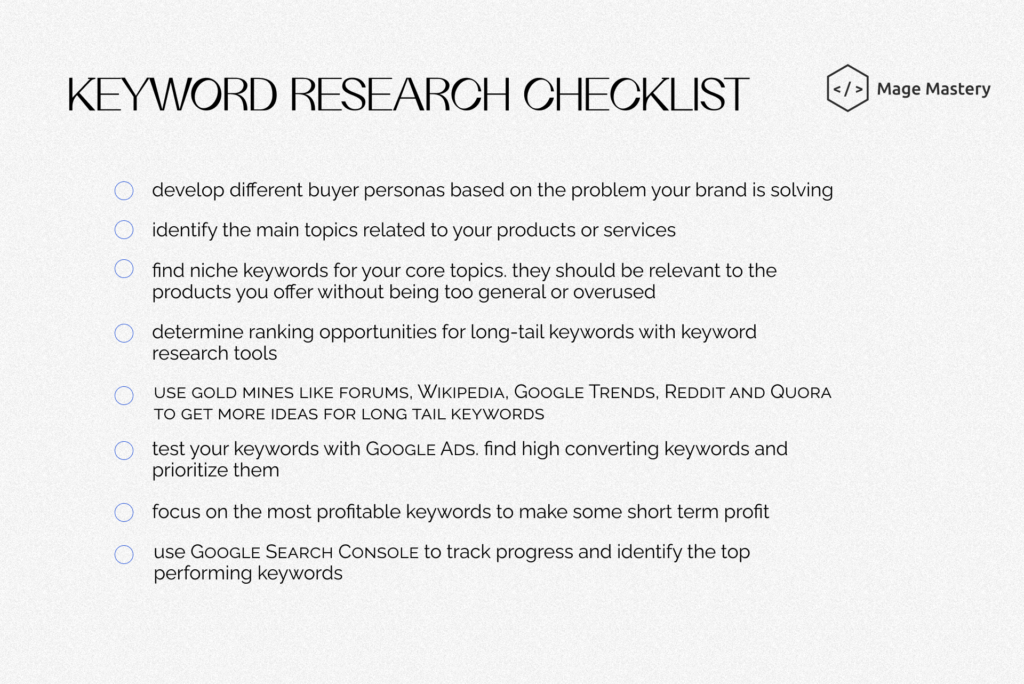Keywords are the foundation of SEO. If no one is looking for what you write about, you won’t get traffic from Google no matter how hard you try.
Keyword research is the process of understanding what language your target buyers use when they search for your product, service, or content. Which then includes analyzing, comparing, and prioritizing the best keyword opportunities on your website.
Why is keyword research important?
Keyword research is the only way to find out what people are typing in search engines. You need to know this so you don’t create content that no one is looking for. Many website owners make this mistake, and it’s probably the main reason why 90.63% of pages don’t get traffic from Google, according to research.
How to do keyword research step by step?
Create buyer personas
Before you start doing keyword research, you need to have an accurate understanding of WHO your audience is, what is important to them, and what they are looking for. Do an SEO analysis of your niche keywords.
The ability to understand your customers is critical to choosing the right keywords. It will also help you determine user intent and optimize content for it.
This is where buyer personas come in.
Buyer personas are a collective image that embodies your target customers. They help you to look at potential customers as ordinary people, and not through the prism of sales. Once you do this, it will be much easier for you to understand what and how they search on Google. And the more you know about your prospect, the better you can determine the keywords they use to find content.

Remember that when creating a buyer persona, you are not limited to one person. Most companies have more than one buyer persona. Create multiple personas based on the different types of customers you hope to attract.
Identify topics relevant to your business
Before you start figuring out WHAT EXACTLY people are looking for, it’s a good idea to brainstorm the broader topics that are relevant to your business. SEO keyword selection will help to conduct more in-depth research in later stages. They will also help you organize your content marketing and structure your website more effectively.
To select topics related to your business, make a list of what you do. These are usually the products or services you provide or the problems your company offers to solve.
For example, if you are in the home renovation and decorating business, you might have the following topics:
- Bathroom renovation
- Kitchen renovation
- Living room renovation
- Bedroom renovation
- Expansion of living space
- Adding a second floor
If you are an Internet marketing agency, you might have topics like:
- Google Search Ads
- Display advertising
- Advertising on YouTube
- Advertising in Bing
- Remarketing
Limit your list to about the five most important topics. Keep in mind that topics are not keywords. This is what you will rely on in the future.
Find niche keywords
Most people who start keyword research use a keyword suggestion tool. They choose keywords that are the most popular, thinking that this will give them the traffic they need.
In other words, they see a ton of different keywords and build their content around them hoping it works. In most cases, this does not happen. Why?
Because when you try to aim for everything, you end up nowhere..

Well-defined long-tail keywords
If you have never used long-tail keywords, you are missing out on an amazing opportunity to increase your traffic and sales conversions. This is one of the fundamental components of white hat SEO.
Long-tail keywords are an essential part of good keyword research. These are longer versions of the main keywords that most companies use. And they make up about 70% of all search queries.
These keywords are important because they help you reach keywords from different stages of the customer journey.
How does it work?
Let’s say you sell furniture. The keyword “selling modern furniture” is aimed at people who are in the buying stage. You should aim for a high ranking for it.
But for most people, the journey begins LONG before they type that keyword into Google. They probably already entered something like the phrases “how to choose a sofa for the living room” or “modern apartments in new buildings in Kyiv” into the search.
By targeting these keywords, you can answer a question that a potential customer had long before they got to the buying stage. If you rank highly for these words, you position yourself as an established company and guide the person through the marketing funnel and help them move to the next stage.
Then, when potential customers are ready to make a purchase, they can enter the phrase “sale of modern furniture” into the search engine. If they see your site again in the search results, they are more likely to click on it. While your keyword “selling modern furniture” drove conversions, it was your “long-tail” keyword that actually brought buyers to your site.
So how do you find long-tail keywords?
You can use the keyword research tools we talked about above. They will help you pinpoint the various long-tail keywords and their search volumes. You can include them in your keyword list and create content based on them.
Use the “gold mine” of search
If you want to order website promotion in Google and rank in this search engine, then Google itself is your best friend. You can use a search engine to find niche keywords, but it’s also convenient to use the relevant keyword gold mines. A good example is the use of forums for keyword research. Forums can be a real gold mine – a source of precious data about your target audience. This is a great tool for your advanced keyword research, providing tons of useful information about your audience.
Learn more: Why do you need a CRM system?
Test your keywords
By now, you probably already have an impressive list of keyword ideas. So how do you narrow down your search and pick the best ones for your business?
It’s simple. Before you start creating content and optimizing your site internally, evaluate keyword importance and search volume with the following steps:
1) Ask yourself key questions
Does the keyword match the content of your site? Will the user get something useful if they use this keyword? Will it ultimately pay off your efforts? If the keyword is good, then you will answer “Yes” to all of these questions.
2) Look for it
Do a Google search for the keyword you are considering. This way you can look at your competitors using it. If you’ve seen a lot of ads, then you’ve probably found a keyword that has value and converts traffic.
3) Test it
Do not immediately start SEO-optimization based on this keyword. Test it with Google Ads. Run a small campaign using the “exact match” option. This will help you figure out how much search and traffic a keyword generates for a given high position.
4) Track it
Run a turnkey advertising campaign for 24 hours and look at the number of conversions you get for a few hundred clicks.
Learn more: 10 features for an eCommerce website
Focus on “low-hanging fruits”
It’s likely that while doing your keyword research, you’ve found a lot of keywords that you rank for and a few that you don’t.
While you CAN go the long way and try to rank for all keywords, it’s smarter to focus on the most profitable opportunities.
Unfortunately, SEO takes time. Even with the best SEO strategy for complex website promotion and keyword research, it can take 8 to 12 months before you get the results you want.
That’s why it’s important to try and lock in some short-term results while you focus on the long-term.
